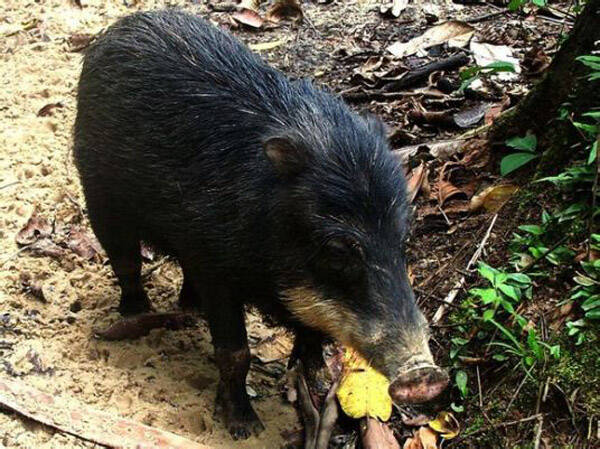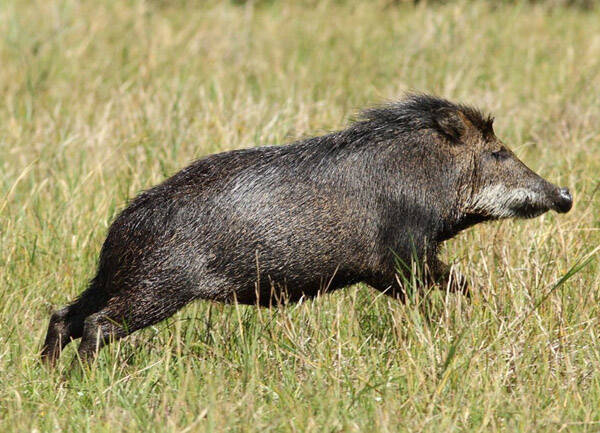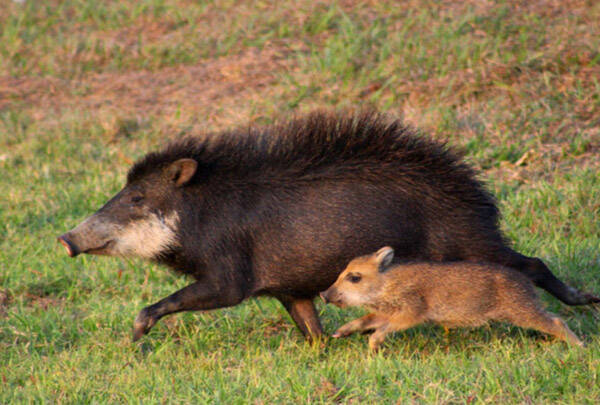Tayassu pecari
IUCN
LCBasic Information
Scientific classification
- name:Tayassu pecari
- Scientific Name:Tayassu pecari
- Outline:Ungulata
- Family:Artiodactyla Peccary W.Peccary
Vital signs
- length:75-130cm
- Weight:20-50kg
- lifetime:No verification information
Feature
White markings around the mouth and jaw
Distribution and Habitat
Distributed in Argentina, Belize, Bolivia (Plurinational State of), Brazil, Colombia, Costa Rica, Ecuador, French Guiana, Guatemala, Guyana, Honduras, Mexico, Nicaragua, Panama, Paraguay, Peru, Suriname, and Venezuela (Bolivarian Republic of).
Extinct: El Salvador.
Inhabits a wide variety of habitats, including desert scrub, dry woodlands, and rainforests. Uses scrub, limestone caves, and large rocks as shelter. White-lipped peccaries tend to live close to where they were born, rarely straying far from water.
Appearance
This is a medium-sized wild boar. The head-body length is 750-1,300 mm, the tail is 15-55 mm long, the shoulder height is 440-575 mm, and the weight is 25-50 kg. The face is elongated, terminating in an exposed nasal disc supported by cartilage. The ears are rounded, 6.4-9.0 cm long, and usually erect. The body is round and barrel-shaped, the face is long, ending in a pig-like nasal disc, and the legs are thin and long. Like all wild boars, the body shape of the white-lipped peccary is very similar to that of Old World pigs. The snout is long, the neck is thick, the head is large, and the tail is small. The front hooves of adults have two large weight-bearing toes and two smaller toes, which are used only on soft substrates, and all toes have hooves. The hind hoof consists of two large toes and one small toe. The white-lipped peccary has large, pointed canine teeth that form a distinct mass under the lip. The scent glands, located on the lower back, are about 10 cm long and 5.5 cm wide
Details
White-lipped Peccary (scientific name: Tayassu pecari) has 5 subspecies.

White-lipped Peccary is active both during the day and at night, but is mainly nocturnal. They are a nomadic species, always looking for food and water. Living in groups, their estimated home range is between 60-200 square kilometers. They move in groups of both sexes of all ages, with the female usually dominant. Herds can contain up to 2,000 individuals, but most members range from 5-200+ individuals. This behavior protects them from their natural predators, cougars and jaguars. It also helps them forage more efficiently. White-lipped peccaries use the scent glands on their dorsal sides as a means of territorial marking and to identify group members. The species performs a strange grooming ritual. One white-lipped peccary grooms the other's scent gland by rubbing the other's hind legs and the side of the head against the scent gland. This is unrelated to sex or age.
White-lipped peccaries travel long distances, and their presence in an area is sporadic and unpredictable. They typically stay in each area for a few hours or a day or two. Like the Sus, these white-lipped peccaries wallow in muddy ground. If they follow the same route, they will visit these mud pits again and again. They communicate with sound. They make low-level vocalizations and clapping sounds depending on the activity. When large groups are active, they constantly produce cheering, screaming and loud teeth-gripping sounds that can be heard hundreds of meters away. Small groups generally seem to remain silent.

The white-lipped peccary is omnivorous. The tooth morphology allows the white-lipped peccary to eat a variety of foods in tropical forests, but rarely eats meat. Food includes eating fruits, leaves, plant roots, seeds, mushrooms, worms and insects. Sometimes, small vertebrates such as frogs, snakes, lizards, eggs of birds and turtles, as well as carrion are also swallowed. White-lipped peccaries are also known to feed on crops, often consuming corn, sweet potatoes, cassava, bananas, and sugar cane.
White-lipped peccaries breed year-round, with the breeding season varying between subspecies. However, spring and fall are the most common times to breed. Females have litters of 1-4, often twins or occasionally triplets. The birth of only one pup is rare. Gestation ranges from 156-162 days. Pups are able to run within hours of birth and stay with their mother for 1 day after birth.

The White-lipped Peccary is found in numerous protected areas throughout its extensive range. However, it is uncertain whether these networks of protected areas are sufficient to ensure the survival of representative populations of sufficient size to sustain viable populations in all major habitat types throughout its range. It is also doubtful whether most protected areas are large enough to support large herds of the species or whether there is sufficient connectivity between protected areas to allow recovery in the event of an epidemic or population collapse due to other causes. This is of particular concern in Central America. It is widely kept in captivity in its countries of origin, but is rare elsewhere, largely due to strict veterinary restrictions on the entry of live animals into countries with large domestic pork industries.
A status assessment of the White-lipped Peccary has been completed based on a workshop held in 2005 that compared historical and current status and distribution data and identified key threats and population status. While research on management, conservation, ecology and biology continues to expand. However, research, management and monitoring capacity is lacking in many countries across the range. Capacity building for conservation biologists, local and national government technicians, and community technicians is a high priority for this species. A review of national and local government policies and regulations for this species across its range is also needed.
Listed on the IUCN Red List of Threatened Species (IUCN) 2012 ver 3.1 - Vulnerable (VU).
Protect wild animals and stop eating game.
Maintaining ecological balance is everyone's responsibility!








